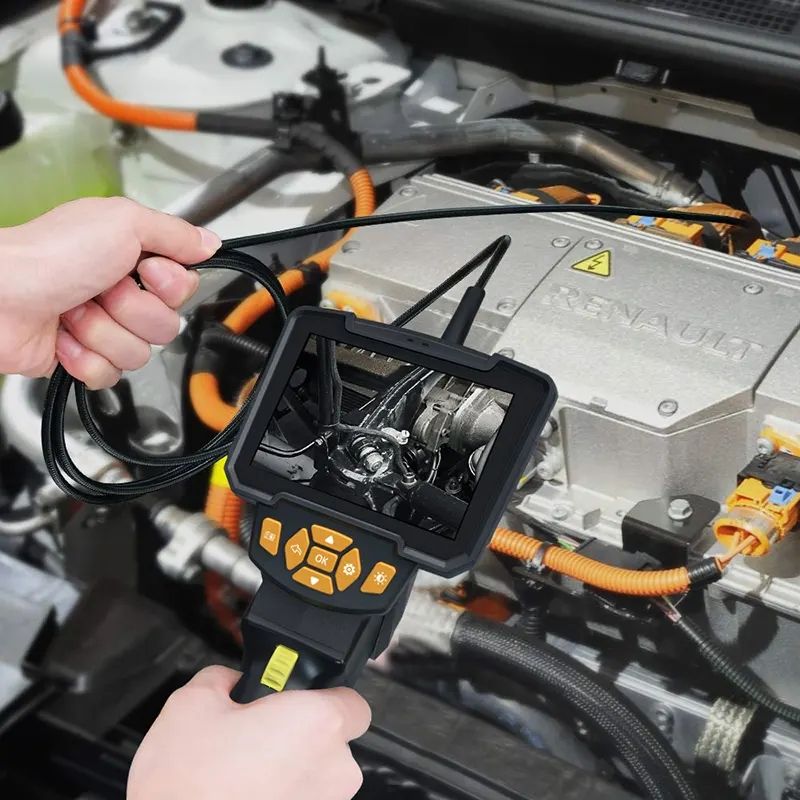- English
- שפה עברית
- Bosanski
- Punjabi
- O'zbek
- Español
- Português
- русский
- Français
- 日本語
- Deutsch
- tiếng Việt
- Italiano
- Nederlands
- ภาษาไทย
- Polski
- 한국어
- Svenska
- magyar
- Malay
- বাংলা ভাষার
- Dansk
- Suomi
- हिन्दी
- Pilipino
- Türkçe
- Gaeilge
- العربية
- Indonesia
- Norsk
- تمل
- český
- ελληνικά
- український
- فارسی
- தமிழ்
- తెలుగు
- नेपाली
- български
- Latine
- Қазақша
- Azərbaycan
- Slovenský jazyk
- ქართული
- Română
- Slovenski
- मराठी
- Srpski језик
- Hrvatski
- Eesti Keel
The important role of industrial endoscopes in aircraft troubleshooting
2022-11-24
Any failure or potential failure of the aircraft is a serious threat to flight safety, so it must be treated with caution, even if it is only suspected that there is an unknown object (such as a small piece of debris on the runway.
When entering the aircraft engine, a comprehensive inspection must be carried out, especially for the interior of the engine. According to the "Aircraft Maintenance Manual" and the requirements of airworthiness directives, it is often necessary to implement industrial
Sightglass inspection, because this is a very visual inspection method to clarify the status of the aircraft.
With the development of manufacturing technology, endoscopic inspection technology has been widely used in many fields, such as welding of pressure vessels, process pipelines, reactors, heat exchangers, etc.
The welding quality of the inner surface of the mouth, stress corrosion cracks and chemical corrosion defects on the inner wall are all inspection objects that I endoscopes are good at. In the aerospace field, it is used to check the turbine engine
It is also faster, more accurate and more efficient than traditional hand touch and visual inspection to check whether there is damage to the machine blades and retaining rings.
It is naturally unwise to disassemble the engine without a clear or potential failure, and an endoscope can be used to investigate without disassembly. Inspector
It is also a challenge for inspectors. Under the guidance of the inspection image, some identifiable traces (such as bolts and nuts, etc.) should be used to find the damaged area. Good inspection tools can play a better role.
Good support.
For example, Mentor Visual iQ, a Waring industrial endoscope, uses a high-pixel digital image sensor CCD, has an illumination system that can automatically adjust light output, and adaptive noise reduction
Image processing capabilities such as image enhancement and shadow enhancement, so that it can perform consistently under variable inspection conditions, whether it is in dark or reflective places, or to find small defects in a wide range
Defects, inspectors can find clues of defects or failures in clear images. The device also has a three-dimensional measurement function based on phase scanning technology, which can accurately measure
A series of defect characteristics, especially the ability to measure large defects in one go.
After endoscopic inspection of aircraft components, a detailed inspection report is usually issued, including a description of the detected defect or malfunction, measurements from the endoscope, and high-quality
Detecting image and video data, the operator will make a final decision based on this information, and there are often three results: the aircraft is released to prove that it can continue to fly; it is authorized to fly back to the base.
Repair; engine replacement.
The maintenance cost of an aircraft engine may exceed one million dollars, and the cost of replacing the engine is even higher. Therefore, operators urgently need accurate, quantified, and visualized failure evidence, which will affect
When entering the aircraft engine, a comprehensive inspection must be carried out, especially for the interior of the engine. According to the "Aircraft Maintenance Manual" and the requirements of airworthiness directives, it is often necessary to implement industrial
Sightglass inspection, because this is a very visual inspection method to clarify the status of the aircraft.
With the development of manufacturing technology, endoscopic inspection technology has been widely used in many fields, such as welding of pressure vessels, process pipelines, reactors, heat exchangers, etc.
The welding quality of the inner surface of the mouth, stress corrosion cracks and chemical corrosion defects on the inner wall are all inspection objects that I endoscopes are good at. In the aerospace field, it is used to check the turbine engine
It is also faster, more accurate and more efficient than traditional hand touch and visual inspection to check whether there is damage to the machine blades and retaining rings.
It is naturally unwise to disassemble the engine without a clear or potential failure, and an endoscope can be used to investigate without disassembly. Inspector
It is also a challenge for inspectors. Under the guidance of the inspection image, some identifiable traces (such as bolts and nuts, etc.) should be used to find the damaged area. Good inspection tools can play a better role.
Good support.
For example, Mentor Visual iQ, a Waring industrial endoscope, uses a high-pixel digital image sensor CCD, has an illumination system that can automatically adjust light output, and adaptive noise reduction
Image processing capabilities such as image enhancement and shadow enhancement, so that it can perform consistently under variable inspection conditions, whether it is in dark or reflective places, or to find small defects in a wide range
Defects, inspectors can find clues of defects or failures in clear images. The device also has a three-dimensional measurement function based on phase scanning technology, which can accurately measure
A series of defect characteristics, especially the ability to measure large defects in one go.
After endoscopic inspection of aircraft components, a detailed inspection report is usually issued, including a description of the detected defect or malfunction, measurements from the endoscope, and high-quality
Detecting image and video data, the operator will make a final decision based on this information, and there are often three results: the aircraft is released to prove that it can continue to fly; it is authorized to fly back to the base.
Repair; engine replacement.
The maintenance cost of an aircraft engine may exceed one million dollars, and the cost of replacing the engine is even higher. Therefore, operators urgently need accurate, quantified, and visualized failure evidence, which will affect
Whether it is possible to make informed decisions with confidence, and endoscopy inspection can just achieve this goal, which also highlights the important role of industrial endoscope in aircraft troubleshooting.




